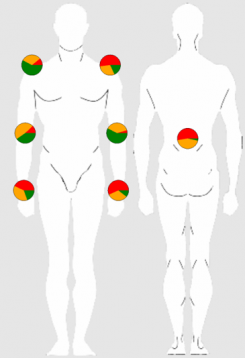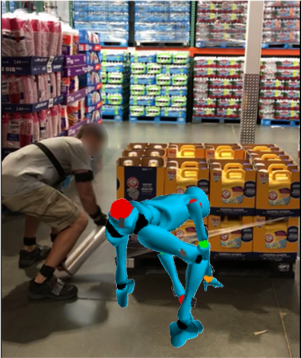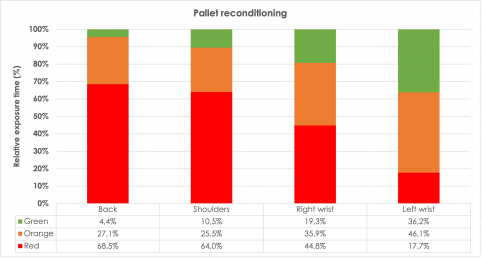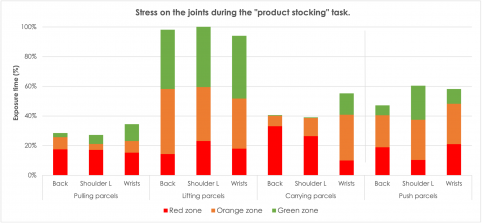Home > Case studies > How to objectify risk factors in the retail sector to improve working conditions?
How to objectify risk factors in the retail sector to improve working conditions?
Context
The retail sector includes many workplaces, in particular logistics activities including handling and carrying loads.
These tasks expose employees to the risk of developing Musculoskeletal Disorders (MSDs). A project to improve working conditions was launched by a major retail company, based on an objective and quantifiable multifactorial
mapping, followed by a diagnosis.
The aim of this ergonomic study is to identify both biomechanical and physiological risks together with the activities
likely to cause them, in order to make recommendations for improvement.
Methodology
The observed work cycle consists of three main tasks: pallet handling, product stocking and pallet reconditioning (including stretch wrapping the remaining products).
The following measurements are performed using sensors and software developed by T.E.A. Ergo :
- Postural constraints on all joints with15 Motion Capture sensors (IMU).
- Amplitude of the muscular efforts on the lumbar muscles with 2 EMG sensors.
- Heart rate for estimating the task intensity with an ECG sensor.
To supplement the analysis, a video of the work situation is automatically synchronized with the measurements in the
CAPTIV software.
Data analysis
Global posture analysis
By means of Motion Capture, postural solicitations of the upper limbs (figure 1) are mapped in a precise and objective manner according to three CAPTIV reference thresholds: green (comfort zone), orange (non-recommended zone) and red (risk zone).
Thresholds

This analysis does highlight significant load on the lumbar region (rotation), on left shoulder (rotation) and for both wrists (extension).
The task analysis timeline created from the video of the workstation shows that the activities at
the origin of these hazardous gestures are pallet reconditioning and product stocking.
Task-specific analysis: pallet reconditioning

During this task, measurements show that the rotation of back and left shoulders, as well as the right wrist extension, are mostly (if not exclusively) in the risk zone (figure 2).
It can thus be observed that hazardous postures represent:
- 68,5% risk exposure time for back rotation
- 64% risk exposure time for left shoulder rotation
- 45% risk exposure time for right wrist extension

During this activity, the lumbar muscles are significantly solicited (beyond the non-recommended threshold) for 22% of the stretch wrapping time.
Task-specific analysis: product stocking
The stockpiling task entails four subtasks: pulling, lifting, carrying and pushing parcels on shelves.
Measurements show that (Figure 3):
- Back and shoulders rotations are under significant constraint when a parcel is lifted,
- Wrists extension and left shoulder rotation are very solicited when a parcel is pushed,
- The tasks of pulling and carrying a parcel cause moderate strain on upper limbs’ joints.

Heart rate analysis shows elevated cardiac stress if the work intensity is maintained over an extended period.
Conclusion
Based on objective metrics obtained using the CAPTIV solution, experts can formulate operational recommendations and implement preventive measures aimed at improving the working conditions of employees.
To fight against musculoskeletal disorders (MSDs), the CAPTIV tool enables to combine several types of physiological data and automatically correlate them with information from workstation mapping. This approach is as innovative as it is effective. In addition to its ease of deployment and versatility, CAPTIV also offers unparalleled possibilities of risks visualizations (3D avatar, diagrams, etc.) while significantly reducing data processing time.
